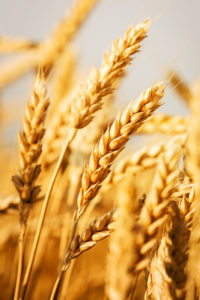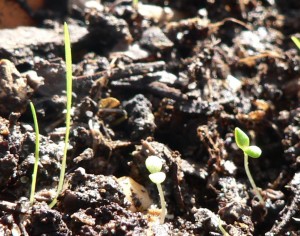 Flowering plants can be divided into monocotyledons and dicotyledons (monocots and dicots). The name is based on how many leaves sprout from the seed, but there are other ways to tell them apart. For monocots, these will be in multiples of three (wheat is an example of a monocot). If you count the number of petals on the flower, it would have either three, six, nine, or a multiple of three. For dicots, the parts will be in multiples of four or five, so a dicot flower might have four petals, five petals, eight, ten, etc.
Flowering plants can be divided into monocotyledons and dicotyledons (monocots and dicots). The name is based on how many leaves sprout from the seed, but there are other ways to tell them apart. For monocots, these will be in multiples of three (wheat is an example of a monocot). If you count the number of petals on the flower, it would have either three, six, nine, or a multiple of three. For dicots, the parts will be in multiples of four or five, so a dicot flower might have four petals, five petals, eight, ten, etc.
Let's start easy...grab a bunch of leaves and lets try to identify them. Here's what you need to know:
[am4show have='p8;p9;p27;p54;p65;' guest_error='Guest error message' user_error='User error message' ]
Materials:
- lettuce or celery
- sharp knife with adult help
- cutting board
- microscope with slides
- flowers of your choice
Download Transpiration Lab (for Monocots & Dicots)
Further Experiments:
-

Source: Wiki Most monocots have veins that are parallel, running side by side. To see an example of this, look at a blade of grass. Most dicots have leaves with veins that form networks. Look at the leaf of lettuce, or a leaf from an oak or maple tree. This is not an absolute test, but it will usually put you on the right path.
- Another test involves cutting the plant's stem. Use a sharp knife to cut through the stem, and then examine it with a magnifying glass or microscope. You are looking for the vascular tissue that carries food and water through the plant. For dicots, the vascular tissue are arranged in rings or lines. For an easy example of that, chop some celery. The "strings" in the celery is the vascular tissue, and you will find them lined up in a nice row. That tells us that celery is a dicot. For monocots, the vascular bundles are spread through the entire stem. While you are chopping your celery, chop some hearts of palm or some bamboo shoots. Neither will have that distinctive row of vascular tubes, since palms and bamboo are both monocots.
- Head for your local grocery store. Look through the produce section, and you should find a wide variety of both monocots and dicots. Most groceries also have a section for live flowers, which will give you a great chance to count some petals.
- Look at your flowers. Which are monocots and which are dicots? Why?
[/am4show]


Wow – good catch! We recently had to redo all the images on the site and I will look to see if this one is in the wrong place. There were a few that were inserted incorrectly – thanks for your help in catching that!
Dear Aurora,
Our kids absolutely love the program (and so do us parents, we learn so much as well!)
Just a question though, in the picture above you have what appears to be a Maidenhair Tree leaf which is a deciduous conifer. I understood that only flowering plants could be classified as dicots or monocots. As conifers are non-flowering is the leaf there as a trick question?
This is one of the very few experiments that didn’t have a worksheet or video – just enjoy the information and them move onto the next one!
Is there a video for this one? Anything to print?
Thanks,
Mark
I am also unable to access the information. It says I do not have access?
Your account shouldn’t be locked – I’ll have our team connect with you to see if there’s an issue with something in your account. You should have access to the K-8 content.
I have four kids and they want to watch different things within k8 content. but it seems you kept most of the things locked. You didn’t say that before i bought the program.